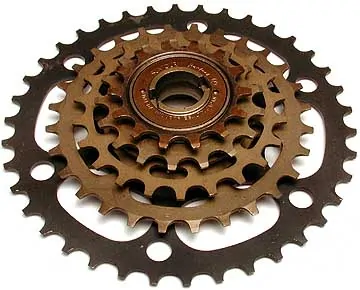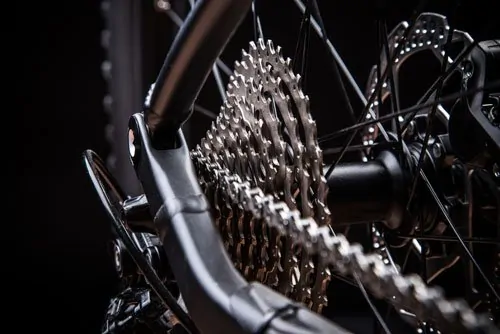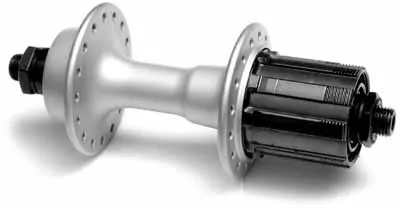The controversy rages on. Freewheel vs Cassette, which type do I have on my bike?
According to the good old’ ever-helpful Sheldon Brown, the terms “freewheel” and “cassette” are often used interchangeably, an error that causes a lot of wasted time and money.”
And he’s not far from right.
By now you know they’re NOT the same! Its a matter of old and new. And how things have panned out over the years.
In this post, we’re going to discuss the main difference between Freewheel and Cassette.
Freewheel vs Cassette Comparison
Freewheels
- Consist of a mechanism that makes coasting possible.
- Commonly 5-, 6- or 7-speeds
- Freewheel is an older version which is screwed on traditional rear hubs
- Freewheels screw onto the hub without any tools for installation and removal.
- Extractor splines do not turn when sprockets are spun backward
- Installing a freewheel is quite easy, and requires no tools at all.
Cassettes
- Built-in ratchet mechanism
- Commonly 7-, 8-, 9- or 10-speeds
- Cassette Freehub is the new standard
- A special tool is needed to remove and retighten the lockring on the road.
- Lockring splines turn with sprockets when spun backward
- Many cassette Freehubs have a distinctive bulge on the right end of the hub barrel.
Steps to determine if a sprocket is a Freewheel or Cassette system
Remove the rear wheel from the bike. Find the tool fitting on the sprocket set.
Spin the sprockets backward.
If the fittings spin with the cogs,
it is a cassette system with a freehub.
If the tool fittings do not spin with the cogs,
it is a threaded freewheel system.
Bicycle Freewheel Thread-on
Generally, a standard freewheel/sprocket cluster could be screwed on traditional rear hubs which came with a standardized set of threads.
As per this structure, any brand of freewheel could be mounted on any brand of the hub.
Further, you could easily unscrew the cluster of sprockets if they were worn out or you simply wanted a different gear ratio and quickly install a new one as a replacement.
What is Freewheel?

A ratchet mechanism that allows the rear sprocket(s) to drive the wheel when pedaled forward, but allows the wheel to turn forward independently even when the sprockets are not turning.
A standard freewheel attaches to a hub by screwing on to external threads that are part of the hub.
So through the action of pedaling, it tightens the freewheel down on the threads. Therefore, no special tools are required to install a freewheel.
However, if you want to remove a freewheel requires a special tool, commonly called a “freewheel puller” or “freewheel extractor”. An example is the park tool freewheel remover.
Freewheels are normally sold with the sprockets attached, so the term Freewheel is frequently used as a synonym for a cluster of sprockets.
Cassette Freehubs
Over the years, the Shimano “Freehub” gradually replaced the conventional threaded rear hub.
As a result of the interchangeability that formerly existed with the traditional rear hubs on which different brands of Freewheels could be screwed on.
However, modern freehubs work so well that they have come to represent the new “standard.”
In fact, most decent-quality bikes made since the late 1980s have used this greatly improved design.
Freehub
A Freehub is a Shimano trademark for a rear hub in which the freewheel mechanism is built into the hub itself, rather than being part of the sprocket cluster. Most freehubs use a cassette of sprockets.
Hub
The middle part of a wheel, to which the inside ends of the spokes attach. A hub consists of an axle, which attaches to the fork ends; a shell, to which the spokes attach, and bearings to connect the axle to the shell, permitting the shell to revolve around the axle.
In the case of a rear hub, the shell would also have a provision for attaching the rear sprocket(s).
Installation
Installing a freewheel is quite easy, and requires no tools at all.
Modern Hyperglide-type cassettes (everything made since the late 1980s) use a threaded lockring to hold the sprockets onto the splines of the Freehub body. There is a special splined tool that fits the notched hole in the lockring.
Removal
Freewheels screw onto the hub without any tools, then, as you ride the bike, your pedaling effort tightens them down.
Apparently, removing a freewheel is a chore, because pedaling tightens it onto the hub threads.
However, with a Freehub, on the other hand, once the sprockets are removed, the right hub flange is accessible for replacement of a broken spoke. There is no need to remove the ratchet mechanism.
A special tool is available to remove and retighten the lockring on the road, using the bicycle’s frame and chain to provide leverage. This tool is of vital importance for a bicycle tourist.
Lubricating
Freewheels should be oiled from time to time with a medium-weight oil.
This is easy to do and generally requires no disassembly. Warning, though: unless the freewheel body is clean, the oil will carry grit and grime into the mechanism!
Sprocket Replacement
Most multi-speed freewheels have replaceable, interchangeable sprockets.
It used to be a common bike-shop service to assemble custom freewheels with any desired combination of sprocket sizes.
Unfortunately, with the general decline in freewheels, replacement sprockets are no longer as readily available as they once were.
They do show up on eBay, and it is also possible to restore an older, worn sprocket with some judicious grinding.
In the late ’80s, Shimano introduced “Hyperglide”, a new sprocket design that allows the chain to engage two adjacent sprockets simultaneously.
It meshes with the new sprocket before it disengages from the old one. This results in smoother, quieter, faster shifting.
To make this work, the rotational position of each sprocket tooth must be aligned to that of the adjacent sprockets.
The older “Uniglide” sprockets could be installed on the body in 9 different orientations (18 if you count the flipped-over positions!) Hyperglide sprockets only go on one way, because one of the splines (tabs) in the sprockets is wider than the others.
This wide spline fits only into a matching wide groove on the Hyperglide body. There is a “^” stamped into the sprocket to help find this wide spline.
Frequently asked Questions (FAQs)
#Is a cassette better than a freewheel?
Beginning around 1980, the Shimano “Freehub” largely replaced the conventional threaded rear hub. It is sad to lose the interchangeability that formerly existed, but these hubs work so well that they have come to represent the new “standard.”
#Can you convert freewheel to cassette?
No, you cannot convert a freewheel to cassette. A freewheel cannot be converted to accept a cassette of any type. In fact, they’re two different things. You may better off with a new hub.
#What does freewheel mean on a bike?
A freewheel is a ratchet mechanism that allows the rear sprocket(s) to drive the wheel when pedaled forward but allows the wheel to turn forward independently even when the sprockets are not turning.
It’s the part which makes coasting possible.
Disclaimer: This article is a curation of facts, thoughts, and content from various external sources especially on the Sheldon Brown website. Most of our claims and views can be verified on sheldonbrown.com
Reference
https://www.sheldonbrown.com/
Also Read:
Garmin 735 vs 935: Which is better? A Comparison Guide
Garmin 935 vs 945: The Ultimate GPS Watch Comparison Guide!
Best Peloton Bluetooth Headphones: What I Wish I Knew!


